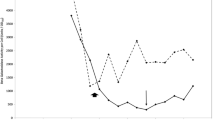Abstract
Culturable counts of antibiotic resistant, genetically engineeredPseudomonas fluorescens were determined on antibiotic-containing plate count agar during starvation in water. Prior to starvation, colony counts obtained on all media separated into two groups. The mean of the colony counts on plate count agar with or without tetracycline (4.9 × 106 ml−1) was significantly higher than the mean colony counts on plate count agar containing either nalidixic acid or nalidixic acid plus tetraclycline (2.5×106 ml−1). After 20 days of starvation the highest mean colony counts continued to be obtained on plate count agar (7.2 × 106 ml−1) with slightly, but significantly, lower counts obtained on plate count agar containing either nalidixic acid (5.6 × 106 ml−1) or tetraclycline (1.5×106 ml−1). A combination of nalidixic acid and tetracycline in plate count agar, however, dramatically reduced colony counts (8.3 × 102 ml−1) after this starvation period. The addition of catalase to plate count agar containing nalidixic acid and tetracycline negated the effect caused by this combination of antibiotics. When colony counts obtained over the entire 20 day incubation were considered, the addition of MgSO4 to plate count agar containing nalidixic acid and tetracycline resulted in a significant increase in colony counts. Other combinations of antibiotics, nalidixic acid+carbenicillin, nalidixic acid+kanamycin, streptomycin+tetracycline, streptomycin+carbenicillin, rifampicin+tetracycline, rifampicin+carbenicillin, and rifampicin+kanamycin, did not inhibit colony formation of starved cells. Antibiotic resistant strains ofP. putida andEscherichia coli also displayed sensitivity to the combination of nalidixic acid and tetracycline in plate count agar after starvation.
Similar content being viewed by others
References
Bagdasarian MM, Amann E, Lurtz R, Ruckert B, Bagdasarian M (1983) Activity of the hybridtrp-lac (tac) promotor ofEscherichia coli inPseudomonas petida. Construction of broad hostrange, controlled-expression vectors. Gene 26:273–282
Caldwell BA, Ye C, Griffiths RP, Moyer, CL, Morita RY (1989) Plasmid expression and maintenance during long-term starvation—Survival of bacteria in well water. Appl Environ Microbiol 55:1860–1864
Chatterjee DK (1988) A novel method to detect genetically altered microorganisms in the environment. In: Omenn GS (ed) Environmental biotechnology: Reducing risks from envirommental chemicals through biotechnology, Plenum Press, New York, p 447
Chatterjee DK, Kellogg ST, Hamada S, Chakrabarty AM (1981) Plasmid specifying total degradation of 3-chlorobenzoate by a modifiedortho pathway. J Bacteriol 146:639–646
Datta N, Hedges RW, Shaw EJ, Sykes RB, Richmond MH (1971) Properties of an R factor fromPseudomonas aeruginosa. J Bacteriol 108:1244–1249
Davis BD, Dulbecco R, Eisen HN, Ginsberg HS, Wood WB (1973) Microbiology Harper and Row, New York
Dawes EA (1985) Starvation survival and energy reserves. In: Fletcher M, Floodgate GD (eds) Bacteria in their natural environments. Academic Press, Orlando, Florida, pp 43–80
Foster TJ (1983) Plasmid-determined resistance to antimicrobial drugs and toxic metal ions in bacteria. Microbiol Rev 47:361–409
Gale EF, Cundliffe E, Reynolds PE, Richmond MH, Waring MJ (1972) The molecular basis of antibiotic action. John Wiley & Sons, London
Giese AC (1973) Cell physiology. W. B. Saunders Co., Philadelphia, Pennsylvania. p 250
Goss WA, Deitz WH, Cook TM (1965) Mechanism of action of nalidixic acid onEscherichia coli. II. Inhibition of deoxyribonucleic acid synthesis. J Bacteriol 89:1068–1074
Holben HJ, Somasegaran P (1982) Comparison of the pour, spread, and drop plate methods for enumeriation ofRhizobium spp. inoculants made for presterilized peat. Appl Environ Microbiol 44:1246–1247
Maniatis T, Fritsch EF, Sambrook J (1982) Molecular cloning A laboratory manual. Cold Spring Harbor, New York.
Martin SE, Flowers RS, Ordal ZJ (1976) Catalase: Its effect on microbial enumeration. Appl Environ Microbiol 32:731–734
Mossel DAA, van Netten P (1984) Harmful effects of selective media on stressed micro-organisms: Nature and remedies. In: Andrew MHE, Russell AD (eds) The revival of injured microbes Academic Press, London, pp 329–351
Postgate JR (1967) Viability measurement and the survival of microbes under minimum stress. Adv Microb Physiol 1:1–23
Rosak DB, Colwell RR (1987) Survival strategies of bacteria in the natural environment. Microbiol Rev 51:365–379
Rossmann R (1980) Soluble element concentrations and complexation in southeastern Lake Michigan. J Great Lakes Res 6(1):47–53
Witter LD, Ordal ZJ (1977) Stress effects and food microbiology. In: Woodbine M (ed) Antibiotics and antibiosis in agriculture. Butterworths, London, pp 131–138
Author information
Authors and Affiliations
Rights and permissions
About this article
Cite this article
Genthner, F.J., Upadhyay, J., Campbell, R.P. et al. Anomalies in the enumeration of starved bacteria on culture media containing nalidic acid and tetracycline. Microb Ecol 20, 283–288 (1990). https://doi.org/10.1007/BF02543883
Received:
Revised:
Issue Date:
DOI: https://doi.org/10.1007/BF02543883




